
So, you want to start (or grow) a private practice? Amazing! You’ve got the skills, the passion, and the drive.
But let’s be real—no one handed you a step-by-step guide on how to build a practice that actually works for you.
Instead, you’re wading through a swamp of imposter syndrome, tech headaches, legal hoops, and marketing mysteries, wondering, Am I even doing this right?
Well, friend, welcome to the 3×10 Approach—a fabulously useful framework that helps you avoid common mistakes, market the right way, and build a practice that doesn’t make you want to cry into your coffee.
Why This Matters
This is your business. Your future. And if you don’t intentionally choose the right practice level and model, you might end up running a business that feels like a trap instead of a dream.
Some people are happiest staying at the Operator Level—and that’s awesome. Others feel stuck there when they really want to be a Founder. The real misery happens when you’re forcing yourself into the Manager Level, running a team when you’d be happier just working with patients, or feeling like a hamster on a wheel at Operator when your soul is screaming to scale to Founder.
So, let’s break this down so you can build a business that actually fits your life.
3 Practice Levels and 10 Practice Models means 1,000 combinations!!!
How to use the following information:
3 Practice Levels – you can start at one level and build to the next, or know your final destination (wise) and plan for that from the start.
10 Practice Models – much more challenging to jump from 1 model to another – not impossible, but not fun! Best if you really research what that model is like and do your best to pick the one model that makes you the most happy and stick to it!
3 Practice Levels
1. Operator Level
At the Operator level, practitioners focus on delivering direct patient care, handling all aspects of their practice independently.
Key Features:
- Typical Earnings: $200,000 to $500,000 annually (or up to $750,000 with a health coach).
- Primary Role: Providing high-quality, personalized care to patients.
- Skills Required: Clinical expertise, patient communication, and basic business management.

Marketing and Sales Challenges:
- Limited Resources: With constrained budgets, Operators may struggle to implement comprehensive marketing strategies.
- Brand Awareness: Building a recognizable brand without dedicated marketing personnel can be challenging.
- Patient Acquisition: Attracting new patients relies heavily on word-of-mouth and limited outreach efforts.
Goals for Growth:
- Develop a basic online presence, including a professional website and social media profiles.
- Leverage patient testimonials to build credibility and attract new patients.
- Utilize cost-effective marketing strategies, such as local community engagement and online directories.

2. Manager Level
Transitioning to the Manager level involves overseeing a team of practitioners, necessitating leadership and operational skills.
Key Features:
- Primary Role: Managing staff, ensuring consistent patient care, and overseeing daily operations.
- Skills Required: Leadership, team management, and process optimization.
- Typical Earnings: $600,000 to $3,000,000 annually.
Marketing and Sales Challenges:
- Marketing for Multiple Practitioners: Developing and executing marketing strategies that effectively promote the diverse specialties and services offered by different practitioners within the practice.
- High Expenses and Lower Profit Margins: Increased operational costs, including salaries, marketing expenditures, and facility maintenance, can lead to tighter profit margins.
- Brand Consistency: Maintaining a unified brand message across multiple practitioners.
- Competitive Positioning: Differentiating the practice in a crowded market.
- Resource Allocation: Balancing marketing investments with operational costs.
Goals for Growth:
- Implement a cohesive marketing strategy that highlights the unique value proposition of the practice.
- Invest in training for staff to ensure consistent patient experiences and service quality.
- Utilize data analytics to track marketing effectiveness and patient acquisition costs.
3. Founder Level
At the Founder level, the focus shifts to strategic growth, scalability, and establishing a lasting legacy.
Key Features:
- Primary Role: Strategic planning, business development, and market expansion.
- Skills Required: Visionary leadership, financial acumen, and advanced marketing strategies.
- Typical Earnings: $2,000,000 to $10,000,000+ annually.

Marketing and Sales Challenges:
- Developing a Strategy to Sell to Cold Traffic at Volume: Creating effective marketing campaigns that convert individuals unfamiliar with the brand into loyal patients at scale.
- Scaling Marketing Efforts: Expanding marketing campaigns to reach a broader audience effectively.
- Brand Reputation: Maintaining and protecting the brand’s reputation on a larger scale.
- Regulatory Compliance: Ensuring all marketing practices adhere to healthcare regulations, such as HIPAA.
Goals for Growth:
- Develop scalable marketing programs, including digital campaigns and strategic partnerships.
- Establish a dedicated marketing team to manage and execute sophisticated marketing strategies.
- Continuously monitor and adapt to industry trends and regulatory changes to maintain compliance and competitive advantage.
Each level presents unique challenges and opportunities in marketing and sales. By understanding and addressing these, practitioners can effectively grow their practices and achieve their professional goals.
10 Practice Models
Choosing the right practice model is one of the most important decisions you will make as a healthcare practitioner or wellness professional. Each model has its own unique benefits, challenges, and requirements. To help you navigate this critical choice, this guide will break down ten common practice models, highlighting typical workflows, staffing needs, patient volumes, marketing demands, legal considerations, and earnings potential.
1. Fee-for-Service Model
Overview
The fee-for-service model operates on a straightforward transactional basis: patients pay for each visit or service at the time it is provided. This approach allows flexibility in pricing and service delivery, making it a common choice for practitioners who are just starting out or prefer not to be tied to long-term patient commitments.
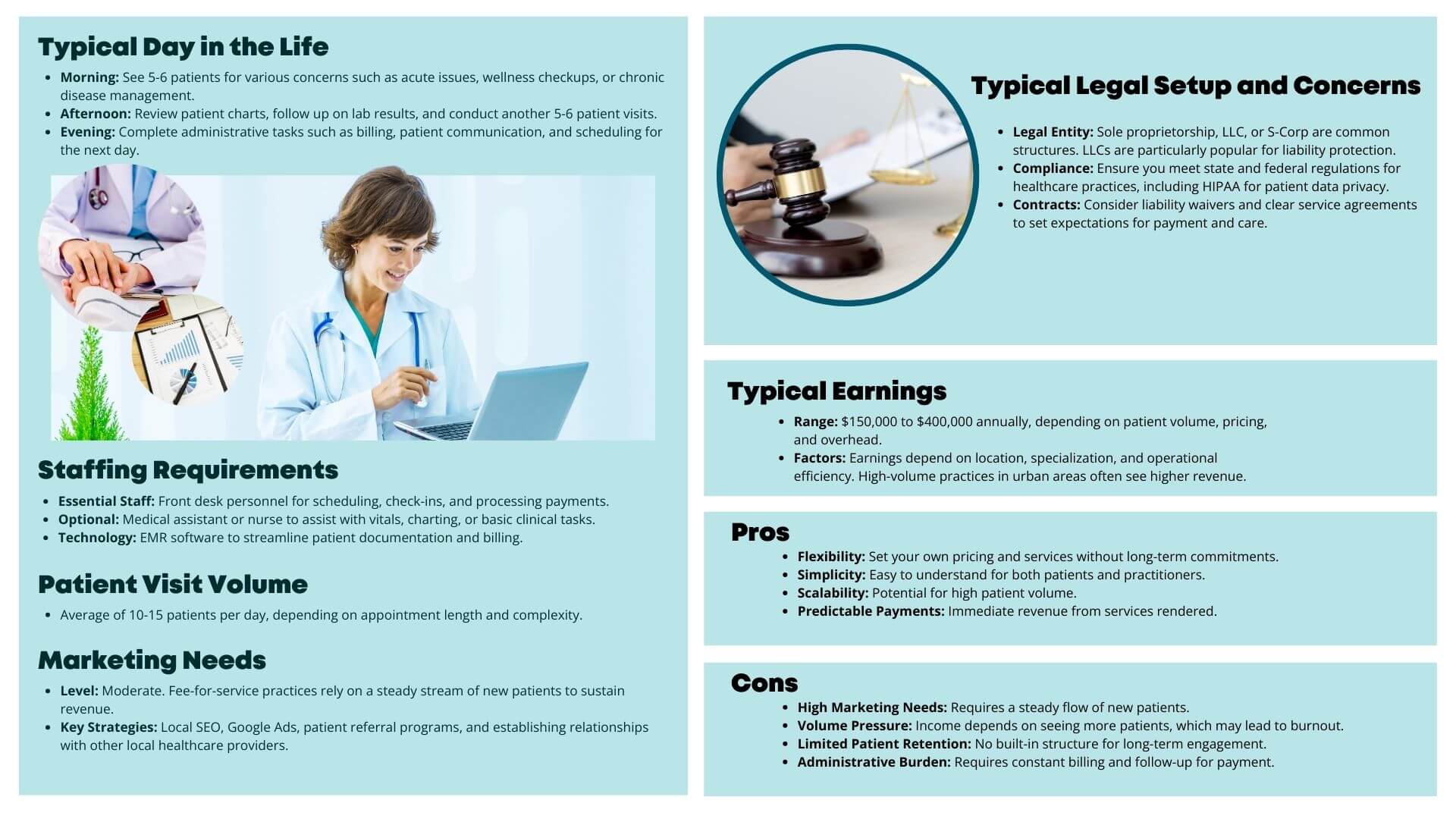
Typical Day in the Life
- Morning: See 5-6 patients for various concerns such as acute issues, wellness checkups, or chronic disease management.
- Afternoon: Review patient charts, follow up on lab results, and conduct another 5-6 patient visits.
- Evening: Complete administrative tasks such as billing, patient communication, and scheduling for the next day.
Staffing Requirements
- Essential Staff: Front desk personnel for scheduling, check-ins, and processing payments.
- Optional: Medical assistant or nurse to assist with vitals, charting, or basic clinical tasks.
- Technology: EMR software to streamline patient documentation and billing.
Patient Visit Volume
- Average of 10-15 patients per day, depending on appointment length and complexity.
Marketing Needs
- Level: Moderate. Fee-for-service practices rely on a steady stream of new patients to sustain revenue.
- Key Strategies: Local SEO, Google Ads, patient referral programs, and establishing relationships with other local healthcare providers.
Typical Legal Setup and Concerns
- Legal Entity: Sole proprietorship, LLC, or S-Corp are common structures. LLCs are particularly popular for liability protection.
- Compliance: Ensure you meet state and federal regulations for healthcare practices, including HIPAA for patient data privacy.
- Contracts: Consider liability waivers and clear service agreements to set expectations for payment and care.
Typical Earnings
- Range: $150,000 to $400,000 annually, depending on patient volume, pricing, and overhead.
- Factors: Earnings depend on location, specialization, and operational efficiency. High-volume practices in urban areas often see higher revenue.
Pros
- Flexibility: Set your own pricing and services without long-term commitments.
- Simplicity: Easy to understand for both patients and practitioners.
- Scalability: Potential for high patient volume.
- Predictable Payments: Immediate revenue from services rendered.
Cons
- High Marketing Needs: Requires a steady flow of new patients.
- Volume Pressure: Income depends on seeing more patients, which may lead to burnout.
- Limited Patient Retention: No built-in structure for long-term engagement.
- Administrative Burden: Requires constant billing and follow-up for payment.
2. Program-Based Model
Overview
In a program-based model, practitioners offer patients comprehensive care plans that span several months. These packages often include a mix of one-on-one visits, educational materials, group coaching, and supplemental products like meal plans or lab tests. This model emphasizes patient outcomes over individual appointments, making it ideal for addressing chronic issues or specific health goals.
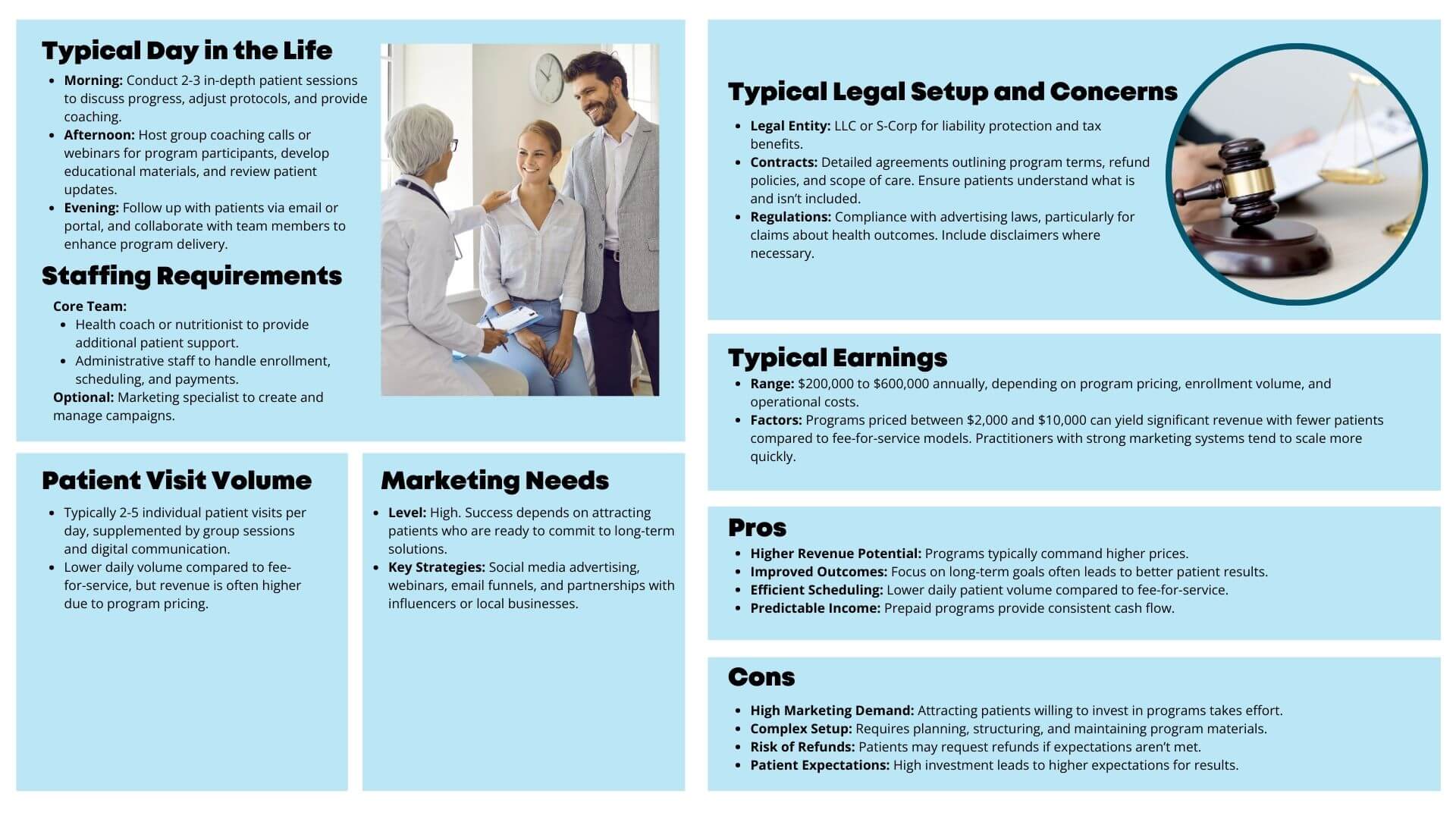
Typical Day in the Life
- Morning: Conduct 2-3 in-depth patient sessions to discuss progress, adjust protocols, and provide coaching.
- Afternoon: Host group coaching calls or webinars for program participants, develop educational materials, and review patient updates.
- Evening: Follow up with patients via email or portal, and collaborate with team members to enhance program delivery.
Staffing Requirements
- Core Team:
- Health coach or nutritionist to provide additional patient support.
- Administrative staff to handle enrollment, scheduling, and payments.
- Optional: Marketing specialist to create and manage campaigns.
Patient Visit Volume
- Typically 2-5 individual patient visits per day, supplemented by group sessions and digital communication.
- Lower daily volume compared to fee-for-service, but revenue is often higher due to program pricing.
Marketing Needs
- Level: High. Success depends on attracting patients who are ready to commit to long-term solutions.
- Key Strategies: Social media advertising, webinars, email funnels, and partnerships with influencers or local businesses.
Typical Legal Setup and Concerns
- Legal Entity: LLC or S-Corp for liability protection and tax benefits.
- Contracts: Detailed agreements outlining program terms, refund policies, and scope of care. Ensure patients understand what is and isn’t included.
- Regulations: Compliance with advertising laws, particularly for claims about health outcomes. Include disclaimers where necessary.
Typical Earnings
- Range: $200,000 to $600,000 annually, depending on program pricing, enrollment volume, and operational costs.
- Factors: Programs priced between $2,000 and $10,000 can yield significant revenue with fewer patients compared to fee-for-service models. Practitioners with strong marketing systems tend to scale more quickly.
Pros
- Higher Revenue Potential: Programs typically command higher prices.
- Improved Outcomes: Focus on long-term goals often leads to better patient results.
- Efficient Scheduling: Lower daily patient volume compared to fee-for-service.
- Predictable Income: Prepaid programs provide consistent cash flow.
Cons
- High Marketing Demand: Attracting patients willing to invest in programs takes effort.
- Complex Setup: Requires planning, structuring, and maintaining program materials.
- Risk of Refunds: Patients may request refunds if expectations aren’t met.
- Patient Expectations: High investment leads to higher expectations for results.
3. Membership Model
Overview
The membership model involves patients paying a recurring monthly or annual fee for access to a predefined set of services. Additional services can often be purchased a la carte, creating flexibility and predictable income for the practice. This model fosters patient retention and loyalty while providing consistent revenue streams.
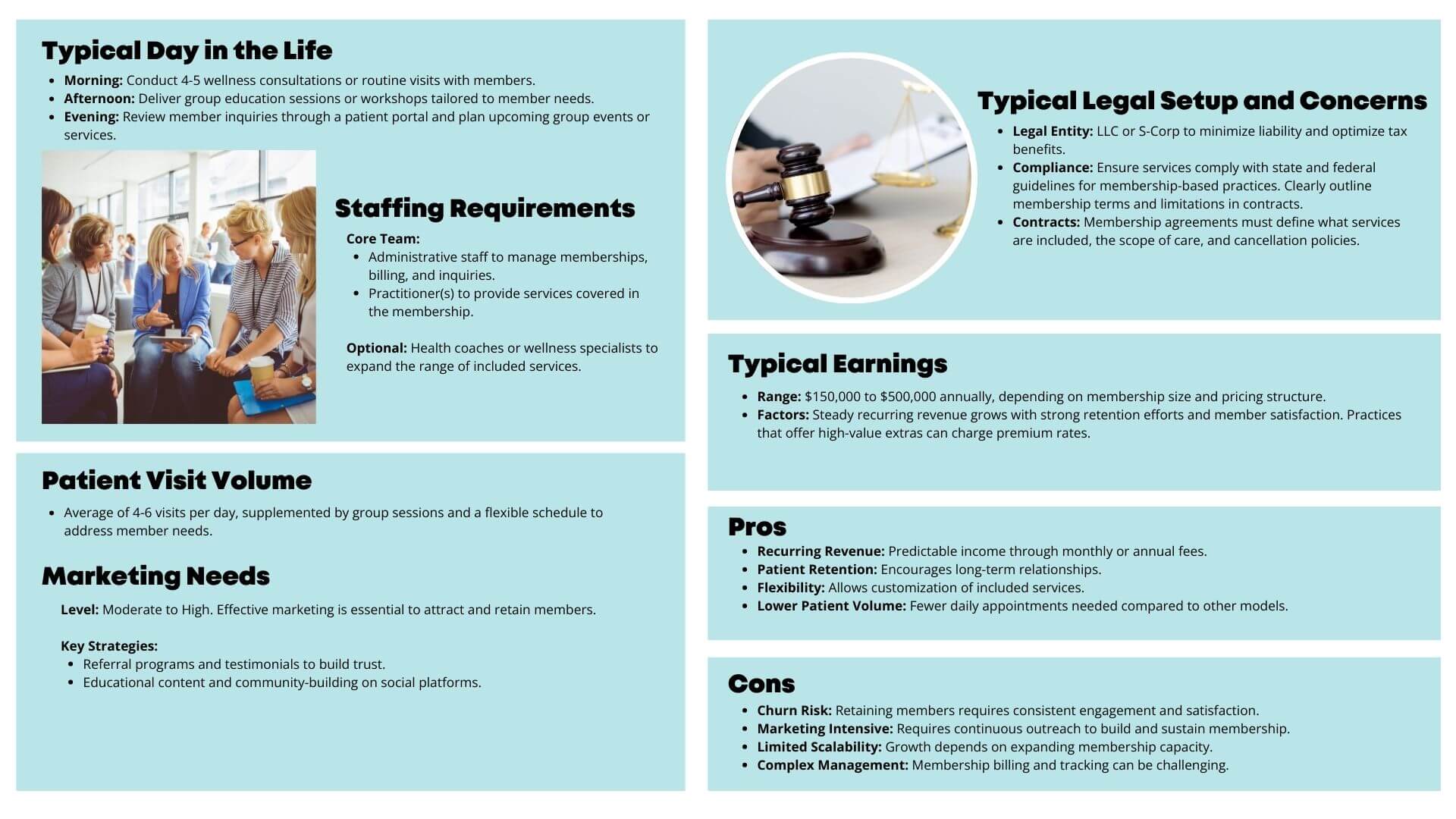
Typical Day in the Life
- Morning: Conduct 4-5 wellness consultations or routine visits with members.
- Afternoon: Deliver group education sessions or workshops tailored to member needs.
- Evening: Review member inquiries through a patient portal and plan upcoming group events or services.
Staffing Requirements
- Core Team:
- Administrative staff to manage memberships, billing, and inquiries.
- Practitioner(s) to provide services covered in the membership.
- Optional: Health coaches or wellness specialists to expand the range of included services.
Patient Visit Volume
- Average of 4-6 visits per day, supplemented by group sessions and a flexible schedule to address member needs.
Marketing Needs
- Level: Moderate to High. Effective marketing is essential to attract and retain members.
- Key Strategies:
- Referral programs and testimonials to build trust.
- Educational content and community-building on social platforms.
Typical Legal Setup and Concerns
- Legal Entity: LLC or S-Corp to minimize liability and optimize tax benefits.
- Compliance: Ensure services comply with state and federal guidelines for membership-based practices. Clearly outline membership terms and limitations in contracts.
- Contracts: Membership agreements must define what services are included, the scope of care, and cancellation policies.
Typical Earnings
- Range: $150,000 to $500,000 annually, depending on membership size and pricing structure.
- Factors: Steady recurring revenue grows with strong retention efforts and member satisfaction. Practices that offer high-value extras can charge premium rates.
Pros
- Recurring Revenue: Predictable income through monthly or annual fees.
- Patient Retention: Encourages long-term relationships.
- Flexibility: Allows customization of included services.
- Lower Patient Volume: Fewer daily appointments needed compared to other models.
Cons
- Churn Risk: Retaining members requires consistent engagement and satisfaction.
- Marketing Intensive: Requires continuous outreach to build and sustain membership.
- Limited Scalability: Growth depends on expanding membership capacity.
- Complex Management: Membership billing and tracking can be challenging.
4. Direct Primary Care (DPC)
Overview
Direct Primary Care is a membership-based model specifically for primary care services. Patients pay a monthly fee in exchange for unrestricted access to routine and preventive care, often bypassing traditional insurance. This model emphasizes patient-centered care and simplicity in billing.
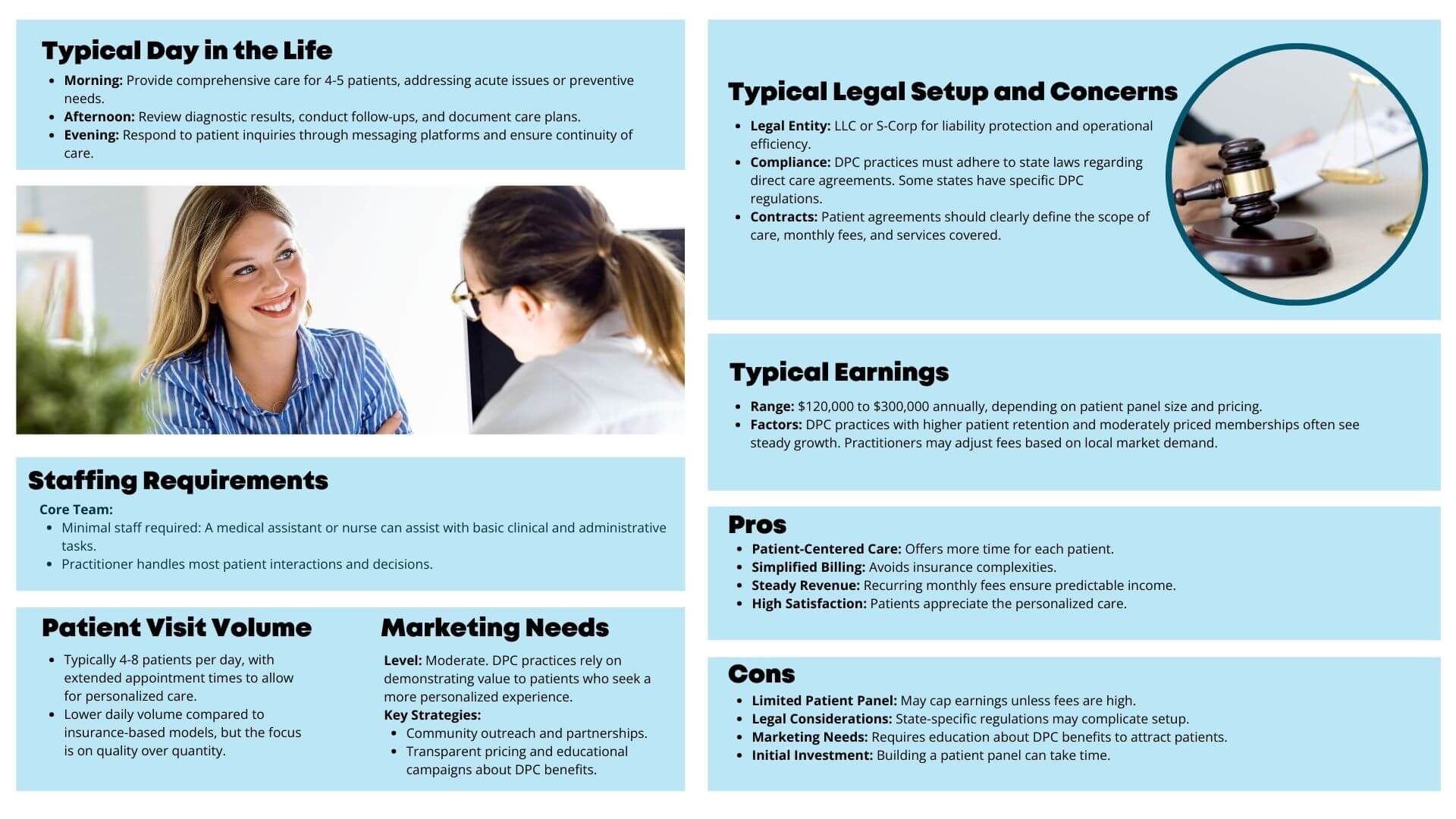
Typical Day in the Life
- Morning: Provide comprehensive care for 4-5 patients, addressing acute issues or preventive needs.
- Afternoon: Review diagnostic results, conduct follow-ups, and document care plans.
- Evening: Respond to patient inquiries through messaging platforms and ensure continuity of care.
Staffing Requirements
- Core Team:
- Minimal staff required: A medical assistant or nurse can assist with basic clinical and administrative tasks.
- Practitioner handles most patient interactions and decisions.
Patient Visit Volume
- Typically 4-8 patients per day, with extended appointment times to allow for personalized care.
- Lower daily volume compared to insurance-based models, but the focus is on quality over quantity.
Marketing Needs
- Level: Moderate. DPC practices rely on demonstrating value to patients who seek a more personalized experience.
- Key Strategies:
- Community outreach and partnerships.
- Transparent pricing and educational campaigns about DPC benefits.
Typical Legal Setup and Concerns
- Legal Entity: LLC or S-Corp for liability protection and operational efficiency.
- Compliance: DPC practices must adhere to state laws regarding direct care agreements. Some states have specific DPC regulations.
- Contracts: Patient agreements should clearly define the scope of care, monthly fees, and services covered.
Typical Earnings
- Range: $120,000 to $300,000 annually, depending on patient panel size and pricing.
- Factors: DPC practices with higher patient retention and moderately priced memberships often see steady growth. Practitioners may adjust fees based on local market demand.
Pros
- Patient-Centered Care: Offers more time for each patient.
- Simplified Billing: Avoids insurance complexities.
- Steady Revenue: Recurring monthly fees ensure predictable income.
- High Satisfaction: Patients appreciate the personalized care.
Cons
- Limited Patient Panel: May cap earnings unless fees are high.
- Legal Considerations: State-specific regulations may complicate setup.
- Marketing Needs: Requires education about DPC benefits to attract patients.
- Initial Investment: Building a patient panel can take time.
5. Concierge Care
Overview
Concierge care offers an elevated level of service at a premium price. Patients pay a high annual or monthly fee for personalized, on-demand access to their provider. This model is ideal for practitioners who want to focus on fewer patients and deliver exceptional, tailored care.
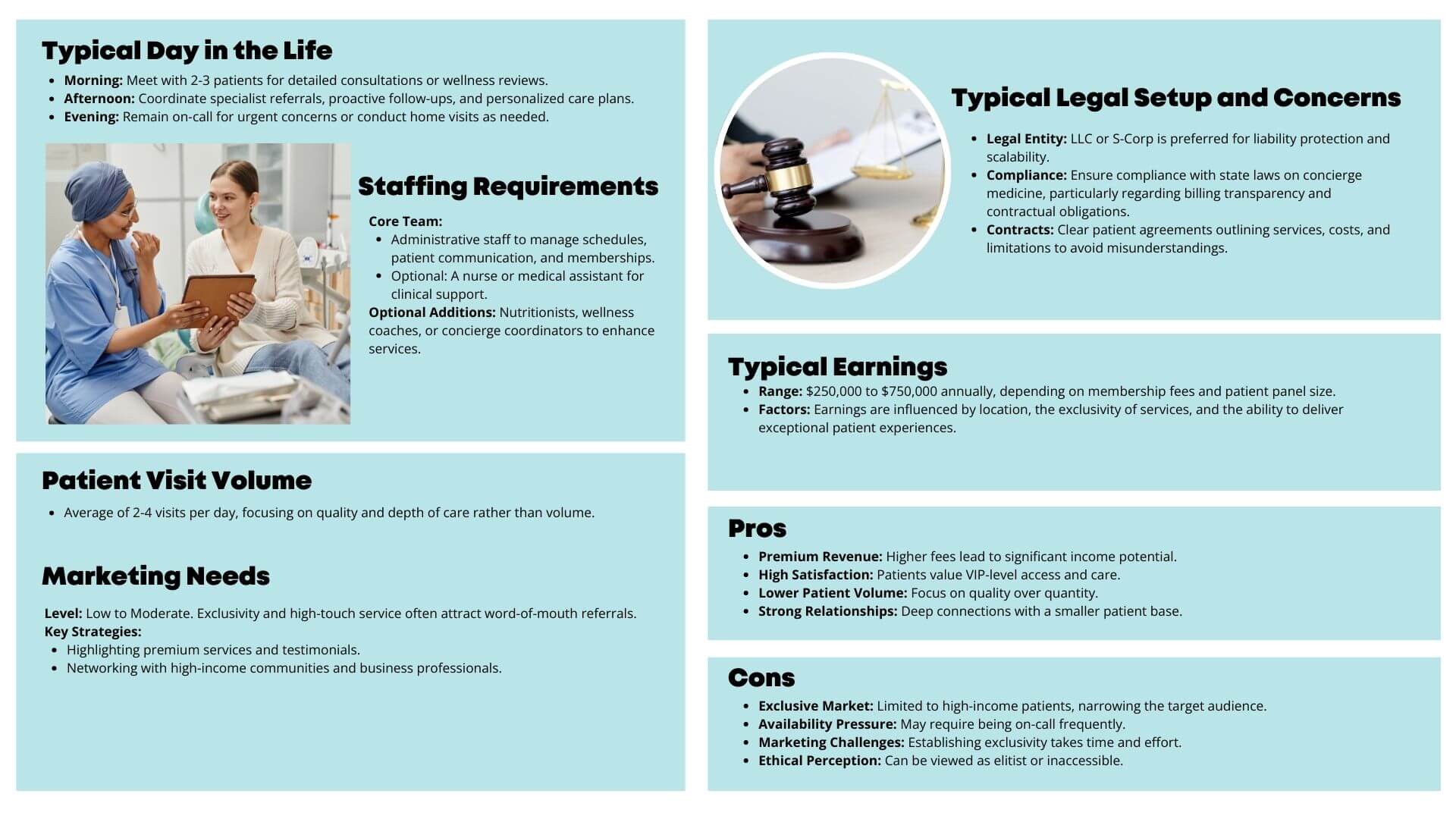
Typical Day in the Life
- Morning: Meet with 2-3 patients for detailed consultations or wellness reviews.
- Afternoon: Coordinate specialist referrals, proactive follow-ups, and personalized care plans.
- Evening: Remain on-call for urgent concerns or conduct home visits as needed.
Staffing Requirements
- Core Team:
- Administrative staff to manage schedules, patient communication, and memberships.
- Optional: A nurse or medical assistant for clinical support.
- Optional Additions: Nutritionists, wellness coaches, or concierge coordinators to enhance services.
Patient Visit Volume
- Average of 2-4 visits per day, focusing on quality and depth of care rather than volume.
Marketing Needs
- Level: Low to Moderate. Exclusivity and high-touch service often attract word-of-mouth referrals.
- Key Strategies:
- Highlighting premium services and testimonials.
- Networking with high-income communities and business professionals.
Typical Legal Setup and Concerns
- Legal Entity: LLC or S-Corp is preferred for liability protection and scalability.
- Compliance: Ensure compliance with state laws on concierge medicine, particularly regarding billing transparency and contractual obligations.
- Contracts: Clear patient agreements outlining services, costs, and limitations to avoid misunderstandings.
Typical Earnings
- Range: $250,000 to $750,000 annually, depending on membership fees and patient panel size.
- Factors: Earnings are influenced by location, the exclusivity of services, and the ability to deliver exceptional patient experiences.
Pros
- Premium Revenue: Higher fees lead to significant income potential.
- High Satisfaction: Patients value VIP-level access and care.
- Lower Patient Volume: Focus on quality over quantity.
- Strong Relationships: Deep connections with a smaller patient base.
Cons
- Exclusive Market: Limited to high-income patients, narrowing the target audience.
- Availability Pressure: May require being on-call frequently.
- Marketing Challenges: Establishing exclusivity takes time and effort.
- Ethical Perception: Can be viewed as elitist or inaccessible.
6. Health Coaching
Overview
Health coaching focuses on guiding clients toward achieving wellness goals through education, motivation, and accountability. It does not involve direct medical care and is perfect for practitioners passionate about lifestyle interventions and holistic health.
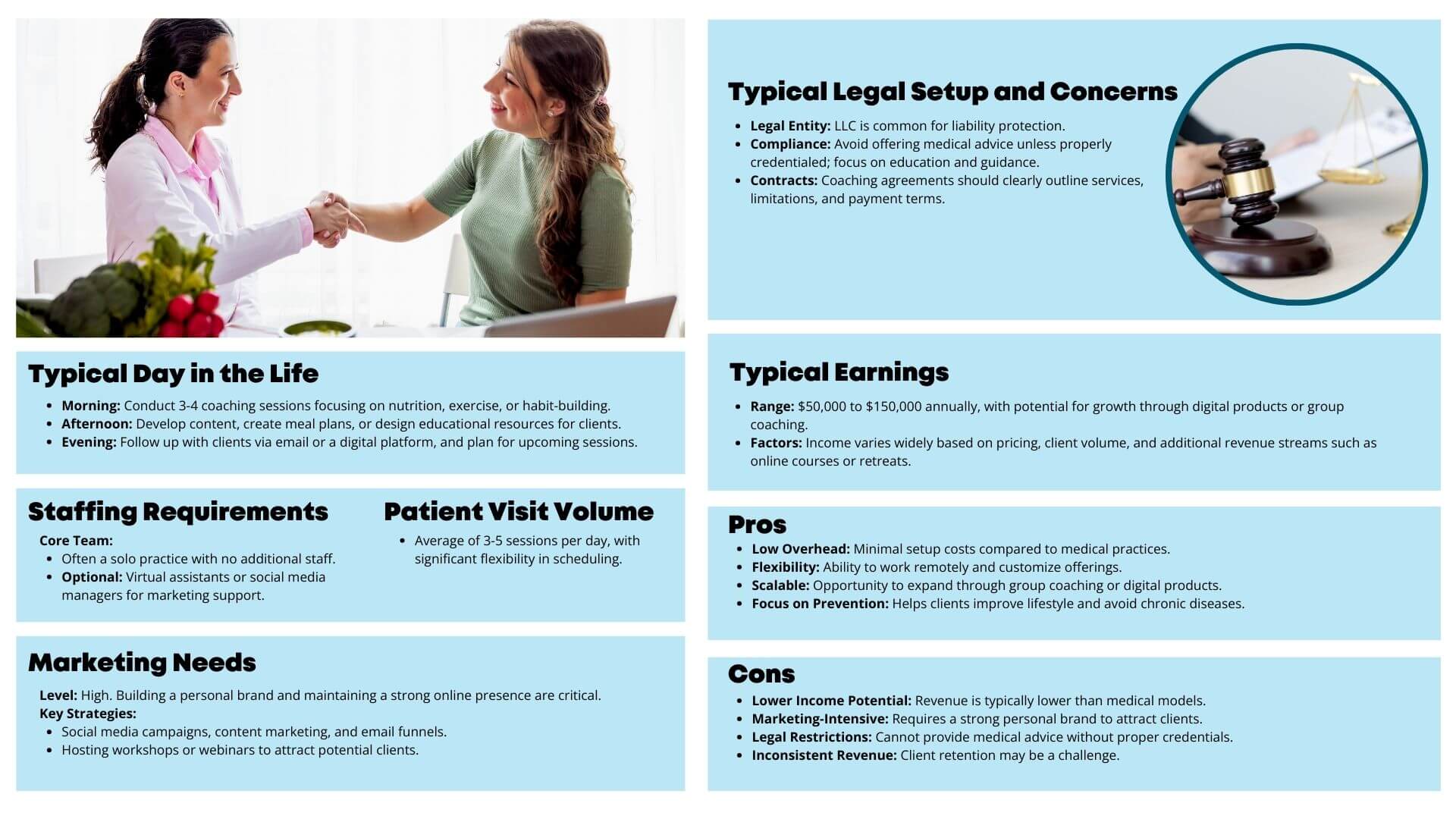
Typical Day in the Life
- Morning: Conduct 3-4 coaching sessions focusing on nutrition, exercise, or habit-building.
- Afternoon: Develop content, create meal plans, or design educational resources for clients.
- Evening: Follow up with clients via email or a digital platform, and plan for upcoming sessions.
Staffing Requirements
- Core Team:
- Often a solo practice with no additional staff.
- Optional: Virtual assistants or social media managers for marketing support.
Patient Visit Volume
- Average of 3-5 sessions per day, with significant flexibility in scheduling.
Marketing Needs
- Level: High. Building a personal brand and maintaining a strong online presence are critical.
- Key Strategies:
- Social media campaigns, content marketing, and email funnels.
- Hosting workshops or webinars to attract potential clients.
Typical Legal Setup and Concerns
- Legal Entity: LLC is common for liability protection.
- Compliance: Avoid offering medical advice unless properly credentialed; focus on education and guidance.
- Contracts: Coaching agreements should clearly outline services, limitations, and payment terms.
Typical Earnings
- Range: $50,000 to $150,000 annually, with potential for growth through digital products or group coaching.
- Factors: Income varies widely based on pricing, client volume, and additional revenue streams such as online courses or retreats.
Pros
- Low Overhead: Minimal setup costs compared to medical practices.
- Flexibility: Ability to work remotely and customize offerings.
- Scalable: Opportunity to expand through group coaching or digital products.
- Focus on Prevention: Helps clients improve lifestyle and avoid chronic diseases.
Cons
- Lower Income Potential: Revenue is typically lower than medical models.
- Marketing-Intensive: Requires a strong personal brand to attract clients.
- Legal Restrictions: Cannot provide medical advice without proper credentials.
- Inconsistent Revenue: Client retention may be a challenge.
7. Medical Spa
Overview
Medical spas combine traditional spa services with medical treatments, offering clients aesthetic procedures like Botox, fillers, laser treatments, and skin rejuvenation. These practices operate in a brick-and-mortar setting and require licensed medical professionals to oversee or perform treatments.
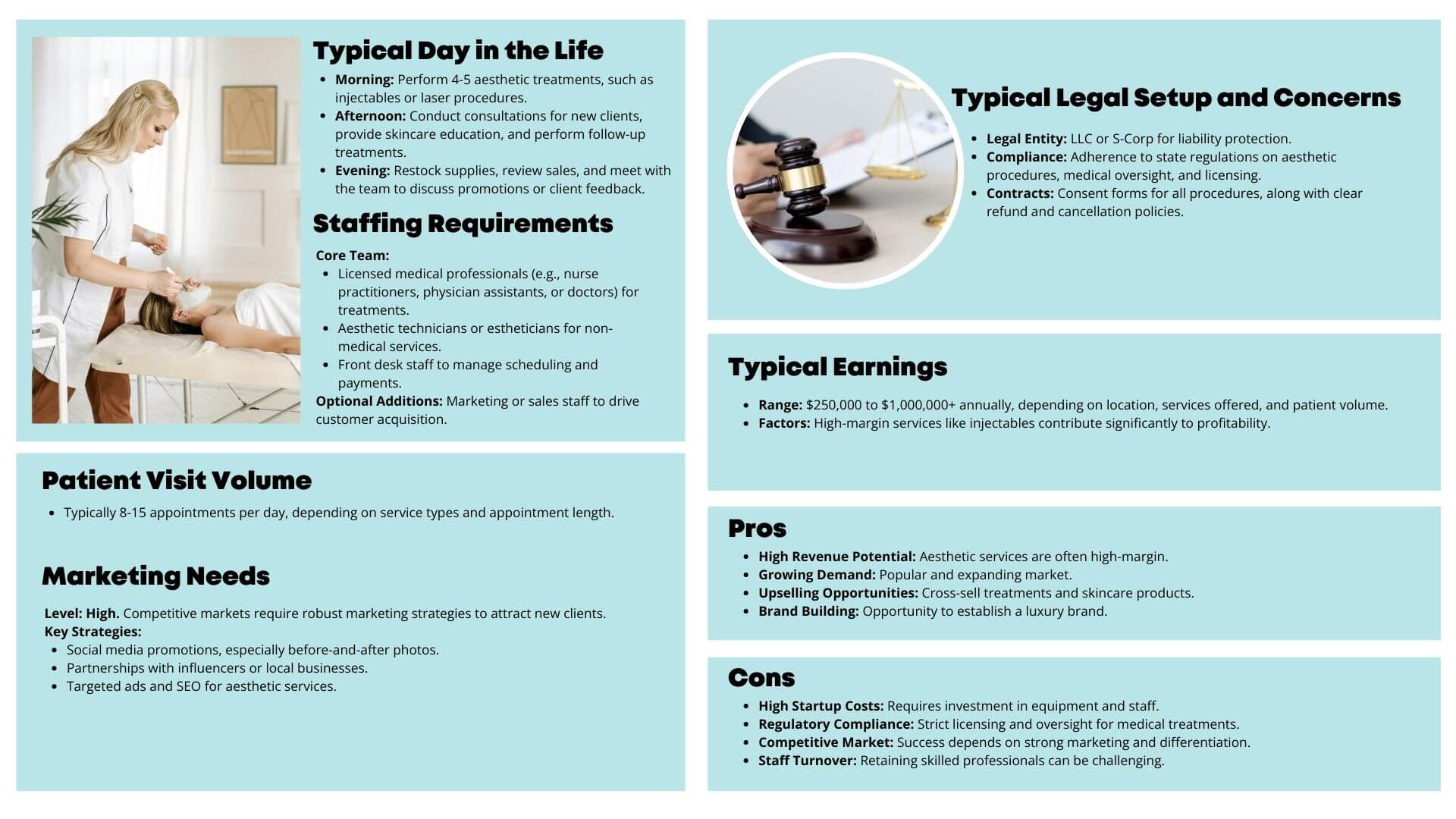
Typical Day in the Life
- Morning: Perform 4-5 aesthetic treatments, such as injectables or laser procedures.
- Afternoon: Conduct consultations for new clients, provide skincare education, and perform follow-up treatments.
- Evening: Restock supplies, review sales, and meet with the team to discuss promotions or client feedback.
Staffing Requirements
- Core Team:
- Licensed medical professionals (e.g., nurse practitioners, physician assistants, or doctors) for treatments.
- Aesthetic technicians or estheticians for non-medical services.
- Front desk staff to manage scheduling and payments.
- Optional Additions: Marketing or sales staff to drive customer acquisition.
Patient Visit Volume
- Typically 8-15 appointments per day, depending on service types and appointment length.
Marketing Needs
- Level: High. Competitive markets require robust marketing strategies to attract new clients.
- Key Strategies:
- Social media promotions, especially before-and-after photos.
- Partnerships with influencers or local businesses.
- Targeted ads and SEO for aesthetic services.
Typical Legal Setup and Concerns
- Legal Entity: LLC or S-Corp for liability protection.
- Compliance: Adherence to state regulations on aesthetic procedures, medical oversight, and licensing.
- Contracts: Consent forms for all procedures, along with clear refund and cancellation policies.
Typical Earnings
- Range: $250,000 to $1,000,000+ annually, depending on location, services offered, and patient volume.
- Factors: High-margin services like injectables contribute significantly to profitability.
Pros
- High Revenue Potential: Aesthetic services are often high-margin.
- Growing Demand: Popular and expanding market.
- Upselling Opportunities: Cross-sell treatments and skincare products.
- Brand Building: Opportunity to establish a luxury brand.
Cons
- High Startup Costs: Requires investment in equipment and staff.
- Regulatory Compliance: Strict licensing and oversight for medical treatments.
- Competitive Market: Success depends on strong marketing and differentiation.
- Staff Turnover: Retaining skilled professionals can be challenging.
8. Mobile Medical Services
Overview
Mobile medical services bring healthcare directly to patients’ homes, workplaces, or community centers. This model offers convenience and accessibility, with services ranging from urgent care to wellness visits or vaccinations.
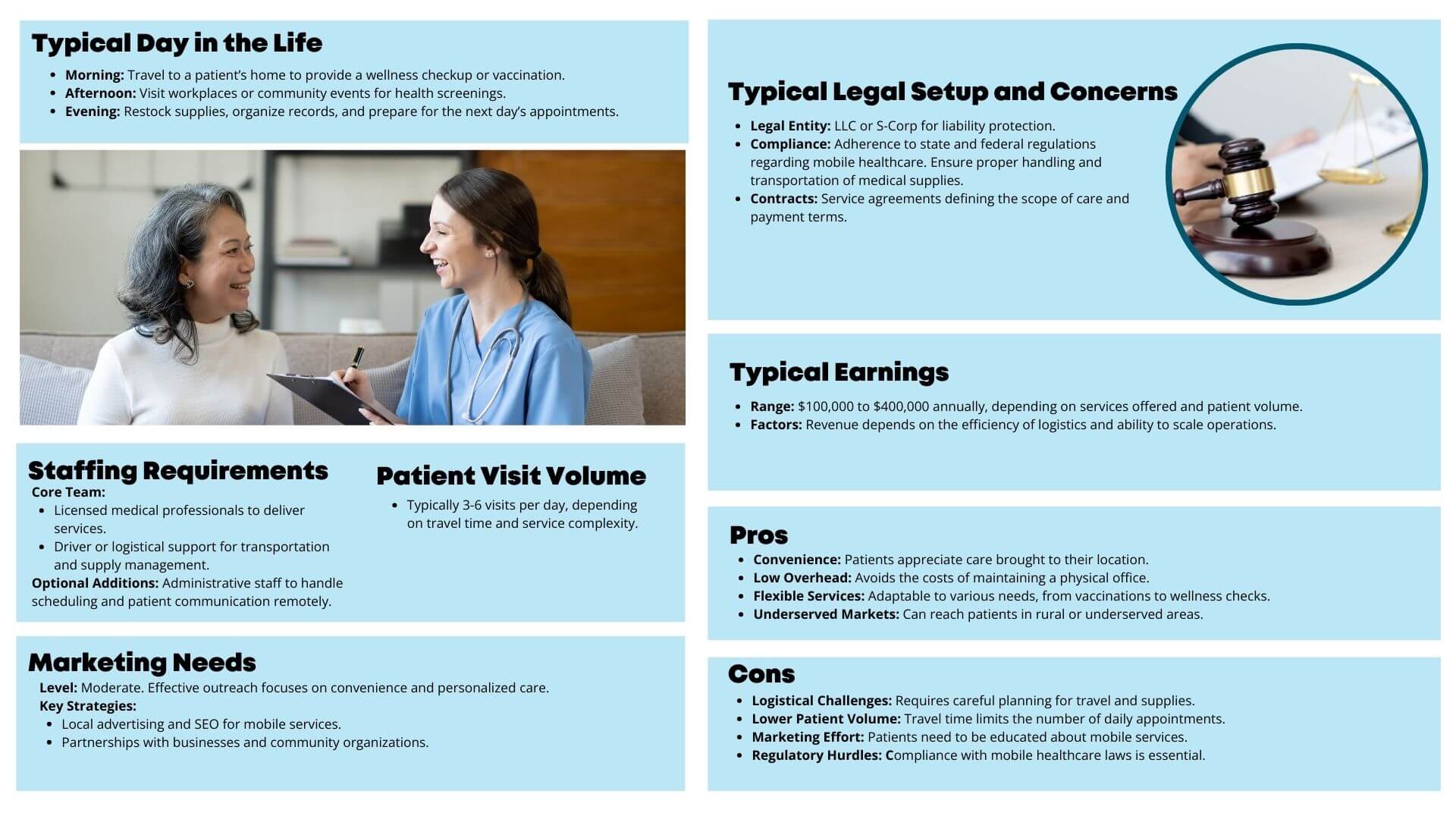
Typical Day in the Life
- Morning: Travel to a patient’s home to provide a wellness checkup or vaccination.
- Afternoon: Visit workplaces or community events for health screenings.
- Evening: Restock supplies, organize records, and prepare for the next day’s appointments.
Staffing Requirements
- Core Team:
- Licensed medical professionals to deliver services.
- Driver or logistical support for transportation and supply management.
- Optional Additions: Administrative staff to handle scheduling and patient communication remotely.
Patient Visit Volume
- Typically 3-6 visits per day, depending on travel time and service complexity.
Marketing Needs
- Level: Moderate. Effective outreach focuses on convenience and personalized care.
- Key Strategies:
- Local advertising and SEO for mobile services.
- Partnerships with businesses and community organizations.
Typical Legal Setup and Concerns
- Legal Entity: LLC or S-Corp for liability protection.
- Compliance: Adherence to state and federal regulations regarding mobile healthcare. Ensure proper handling and transportation of medical supplies.
- Contracts: Service agreements defining the scope of care and payment terms.
Typical Earnings
- Range: $100,000 to $400,000 annually, depending on services offered and patient volume.
- Factors: Revenue depends on the efficiency of logistics and ability to scale operations.
Pros
- Convenience: Patients appreciate care brought to their location.
- Low Overhead: Avoids the costs of maintaining a physical office.
- Flexible Services: Adaptable to various needs, from vaccinations to wellness checks.
- Underserved Markets: Can reach patients in rural or underserved areas.
Cons
- Logistical Challenges: Requires careful planning for travel and supplies.
- Lower Patient Volume: Travel time limits the number of daily appointments.
- Marketing Effort: Patients need to be educated about mobile services.
- Regulatory Hurdles: Compliance with mobile healthcare laws is essential.
9. Retail Establishment
Overview
Retail establishments, such as pharmacies, supplement shops, or wellness boutiques, provide healthcare-related products and services directly to customers. These practices focus on a brick-and-mortar setup with a significant emphasis on product sales and customer education.
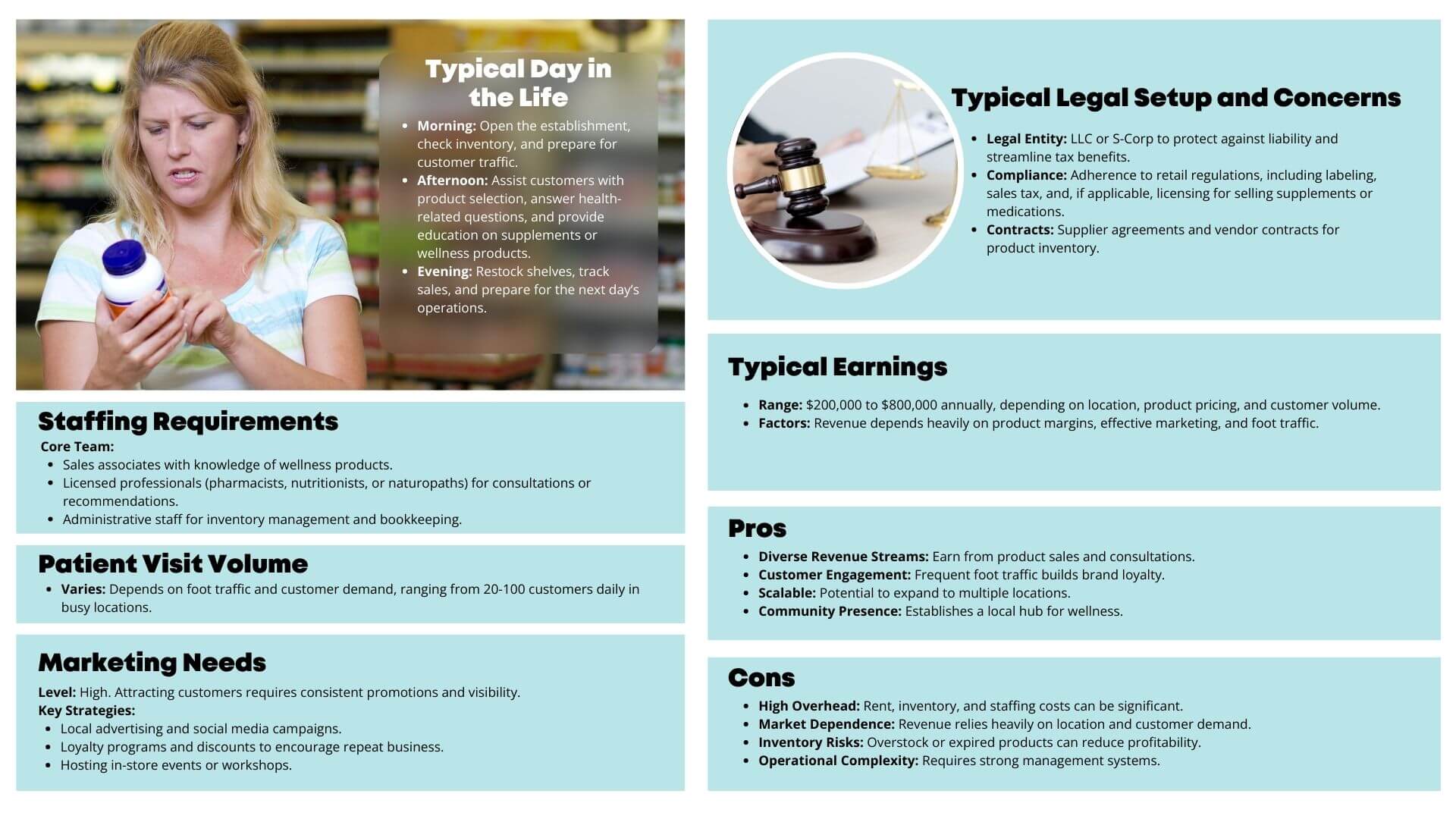
Typical Day in the Life
- Morning: Open the establishment, check inventory, and prepare for customer traffic.
- Afternoon: Assist customers with product selection, answer health-related questions, and provide education on supplements or wellness products.
- Evening: Restock shelves, track sales, and prepare for the next day’s operations.
Staffing Requirements
- Core Team:
- Sales associates with knowledge of wellness products.
- Licensed professionals (pharmacists, nutritionists, or naturopaths) for consultations or recommendations.
- Administrative staff for inventory management and bookkeeping.
Patient Visit Volume
- Varies: Depends on foot traffic and customer demand, ranging from 20-100 customers daily in busy locations.
Marketing Needs
- Level: High. Attracting customers requires consistent promotions and visibility.
- Key Strategies:
- Local advertising and social media campaigns.
- Loyalty programs and discounts to encourage repeat business.
- Hosting in-store events or workshops.
Typical Legal Setup and Concerns
- Legal Entity: LLC or S-Corp to protect against liability and streamline tax benefits.
- Compliance: Adherence to retail regulations, including labeling, sales tax, and, if applicable, licensing for selling supplements or medications.
- Contracts: Supplier agreements and vendor contracts for product inventory.
Typical Earnings
- Range: $200,000 to $800,000 annually, depending on location, product pricing, and customer volume.
- Factors: Revenue depends heavily on product margins, effective marketing, and foot traffic.
Pros
- Diverse Revenue Streams: Earn from product sales and consultations.
- Customer Engagement: Frequent foot traffic builds brand loyalty.
- Scalable: Potential to expand to multiple locations.
- Community Presence: Establishes a local hub for wellness.
Cons
- High Overhead: Rent, inventory, and staffing costs can be significant.
- Market Dependence: Revenue relies heavily on location and customer demand.
- Inventory Risks: Overstock or expired products can reduce profitability.
- Operational Complexity: Requires strong management systems.
10. Medical-Connected Brand
Overview
Medical-connected brands focus on developing a strong identity through products, services, or digital offerings. Examples include selling medical devices, creating online education platforms, or building a personal brand around medical expertise.
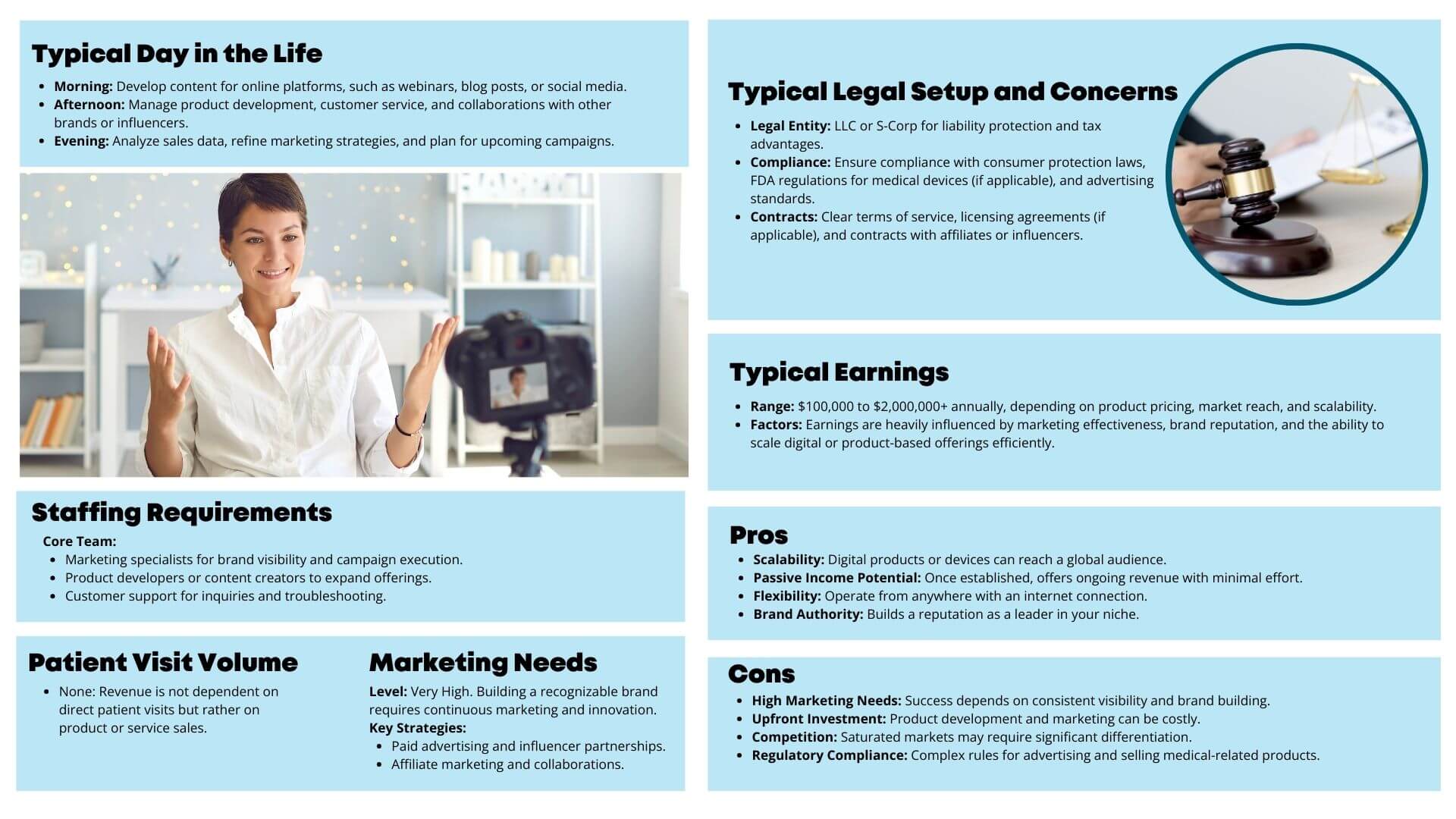
Typical Day in the Life
- Morning: Develop content for online platforms, such as webinars, blog posts, or social media.
- Afternoon: Manage product development, customer service, and collaborations with other brands or influencers.
- Evening: Analyze sales data, refine marketing strategies, and plan for upcoming campaigns.
Staffing Requirements
- Core Team:
- Marketing specialists for brand visibility and campaign execution.
- Product developers or content creators to expand offerings.
- Customer support for inquiries and troubleshooting.
Patient Visit Volume
- None: Revenue is not dependent on direct patient visits but rather on product or service sales.
Marketing Needs
- Level: Very High. Building a recognizable brand requires continuous marketing and innovation.
- Key Strategies:
- Paid advertising and influencer partnerships.
- Affiliate marketing and collaborations.
Typical Legal Setup and Concerns
- Legal Entity: LLC or S-Corp for liability protection and tax advantages.
- Compliance: Ensure compliance with consumer protection laws, FDA regulations for medical devices (if applicable), and advertising standards.
- Contracts: Clear terms of service, licensing agreements (if applicable), and contracts with affiliates or influencers.
Typical Earnings
- Range: $100,000 to $2,000,000+ annually, depending on product pricing, market reach, and scalability.
- Factors: Earnings are heavily influenced by marketing effectiveness, brand reputation, and the ability to scale digital or product-based offerings efficiently.
Pros
- Scalability: Digital products or devices can reach a global audience.
- Passive Income Potential: Once established, offers ongoing revenue with minimal effort.
- Flexibility: Operate from anywhere with an internet connection.
- Brand Authority: Builds a reputation as a leader in your niche.
Cons
- High Marketing Needs: Success depends on consistent visibility and brand building.
- Upfront Investment: Product development and marketing can be costly.
- Competition: Saturated markets may require significant differentiation.
- Regulatory Compliance: Complex rules for advertising and selling medical-related products.
Best Practice Models for Each Practice Level
When choosing a model, it’s essential to consider your goals, preferred work style, and revenue aspirations. Below, we analyze which of the ten models are best suited for practitioners operating at three distinct levels: Operator, Manager, and Founder.
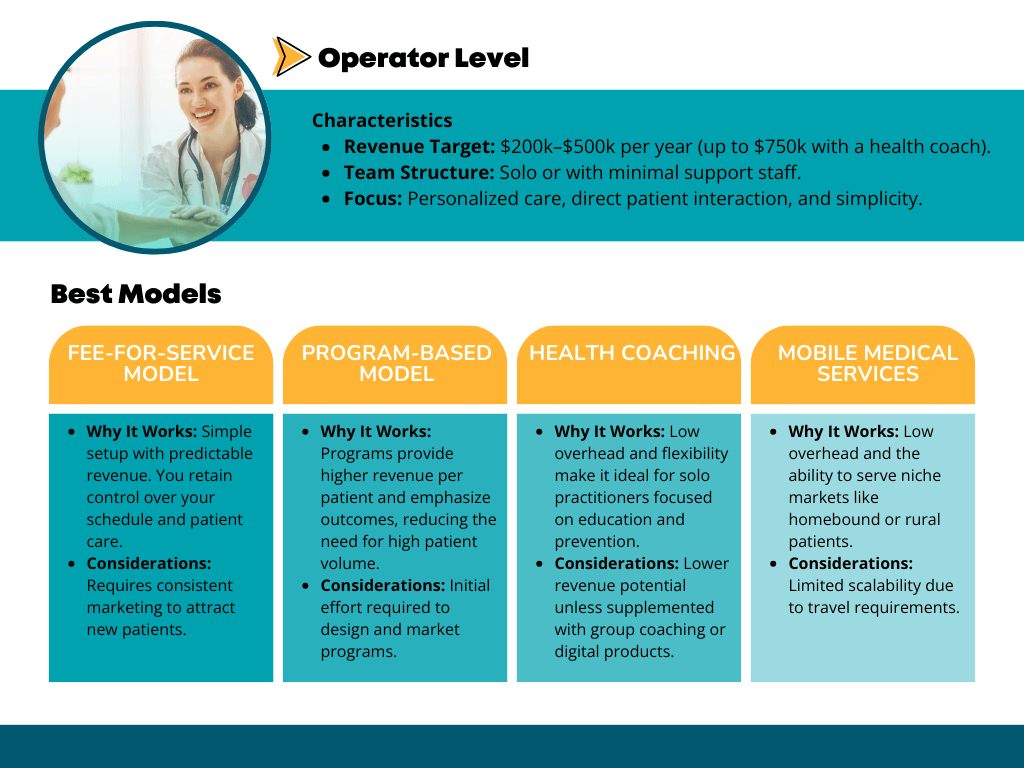
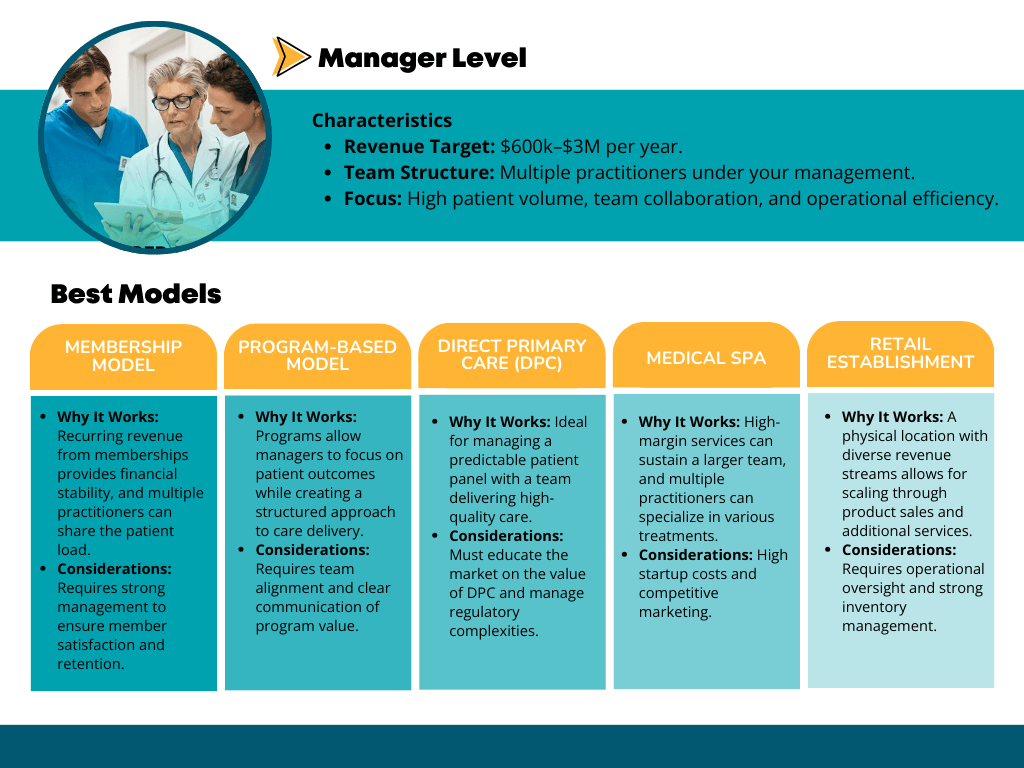
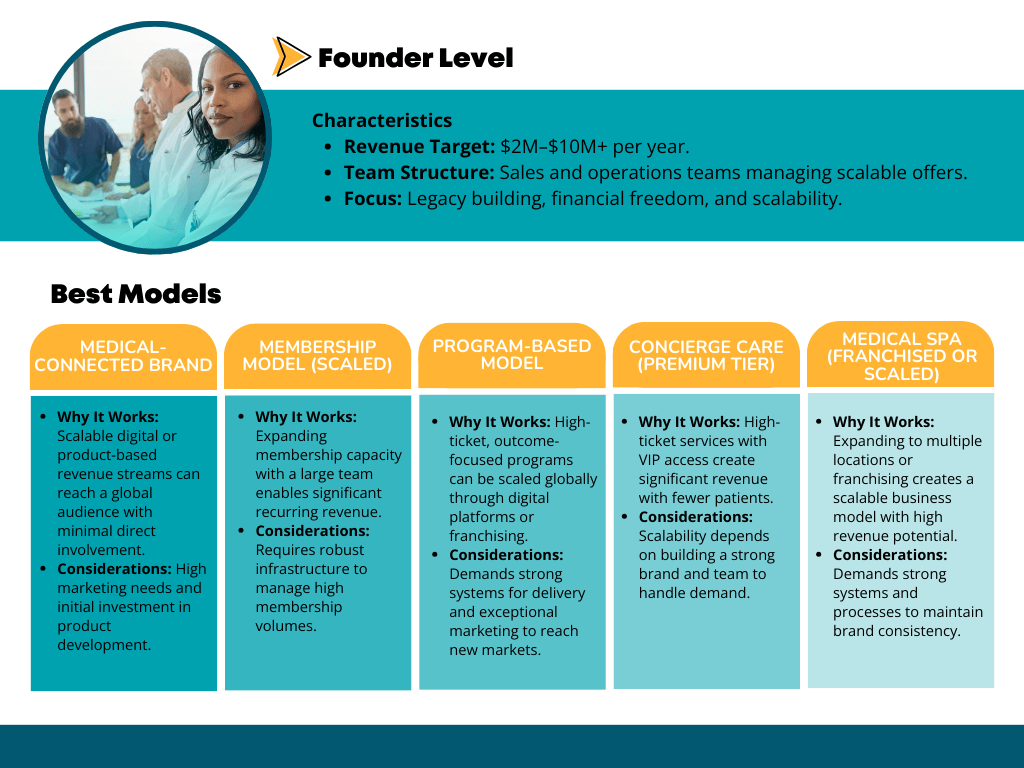
Want to chat about what YOU need? Whether you are a Dreamer (hmm…maybe I want to do this?), a Doer (I’ve started, but need more new patients), or a Driver (I’m successful, ready to scale!) – we’ve got the experienced team ready to help answer your questions. Chat with our team HERE.
